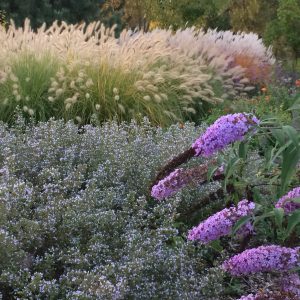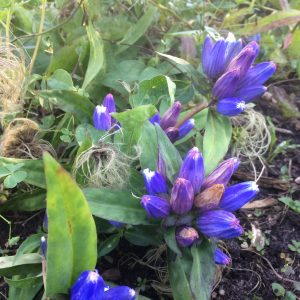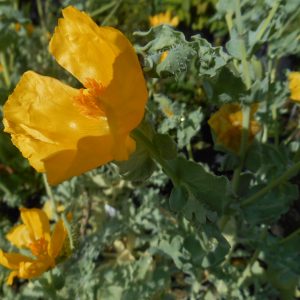Archives
Showing 81–88 of 199 results
-
Engelmannia peristenia syn. E. pinnatafida Engelmann’s Daisy Z 4-8
Clusters of golden-yellow daisy-like flowers, May-August, over an evergreen rosette
ARCHIVED
Note: This is a plant not currently for sale. This is an archive page preserved for informational use.
Clusters of golden-yellow daisy-like flowers, May-August, over an evergreen rosette
Size: 18-36” x 15-18”
Care: full sun in well-drained soil. Drought tolerant.
Native: South central US
Wildlife Value: Attracts birds for the seeds, Bees & butterflies for nectar/pollen. Rabbit resistant.First published in 1840 by Nuttal/Gray. Named for George Engelmann (1809-1884) who was born in Germany and settled in St. Louis, Missouri, as a young man. He was a physician and botanist. When he died much of his collection went to Missouri Botanical Garden.
-
Eryngium amethystinum Amethyst sea holly Z. 3-8
Metallic amethyst stems, spiny bracts and cone-shaped flower in July and August
ARCHIVED
Note: This is a plant not currently for sale. This is an archive page preserved for informational use.
Metallic amethyst stems, spiny bracts and cone-shaped flower in July and August
Size: 28” x 28”
Care: Full sun in well-drained soil, drought tolerant
Native: Italy & southern Alps
Wildlife Value: attracts bees & butterflies, birds eat seeds. Deer & rabbit resistant
Awards: Great Plant Pick Award from Elizabeth Carey Miller Botanical Garden.Garden cultivation since 1648. Long prized for its metallic luster.
-
Euonymus carnosus Flesh-flowered Spindletree Z 4-7
Small tree bearing white flowers in spring turning to red berries in fall. Glossy foliage turns purple in fall.
ARCHIVED
Note: This is a plant not currently for sale. This is an archive page preserved for informational use.
Small tree bearing white flowers in spring turning to red berries in fall. Glossy foliage turns purple in fall.
Size: 8-12' x 6'
Care: Sun to part shade in well-drained soil
Native: China & Japan
Wildlife Value: attracts bees & birdsCollected by 1886
-
Fall Garden for sun
Fall Blooming Garden for sun.
ARCHIVED
Note: This collection is not currently for sale. This is an archive page preserved for informational use.
Fall garden for Sun Size : Height x width* Bloom color
3 Aster cordifolius – Blue wood aster 2-3’ x 2-3’ blue
1 Boltonia asteroides – Bolton’s aster 5-6’ x 3’ white
1 Chrysanthemum ‘Clara Curtis’ 2’ x 2’ pink
1 Imperata cylindrical – Japanese bloodgrass 16-20” x 12” red leaves
1 Miscanthus purpurascens – Flame grass 4-5’ x 3-4’ orange-red leaves
1 Nipponanthemum nipponicum – Nippon daisy 2-3’ x 2-3’ white
1 Pennisetum orientale – Oriental fountaingrass 2′ x 2′ pink
1 Persicaria affinis – Dwarf fleeceflower 8-12” x 3’ red
3 Sedum sieboldii – October daphne 4” x 8” pink
3 Sedum spurium ‘Coccineum’ – Dragon’s blood 6” x 24” redAll plants are perennials.
If planted together in one garden these make a 36 square foot garden. **Most of these plants get wider over time by spreading roots or by self-seeding . -
Fragrant Garden for sun
ARCHIVED Note: This collection is a not currently for sale. This is an archive page preserved for informational use. Fragrant Garden for sun Size: Height x width * Bloom color 3 Agastache foeniculum – Anise hyssop 2-3’ x 12” purple 1 Buddleja davidii – Butterfly bush […]
ARCHIVED
Note: This collection is a not currently for sale. This is an archive page preserved for informational use.
Fragrant Garden for sun Size: Height x width * Bloom color
3 Agastache foeniculum – Anise hyssop 2-3’ x 12” purple
1 Buddleja davidii – Butterfly bush 6’ x 4’ purple
1 Clematis ternifolia – Sweet autumn 15-20’ x 6-10’ white
3 Lavandula angustifolia ‘Munstead’ 12-18” x 12-18” lavender
1 Lilium auratum – Gold band lily 2-5’ x 12” white/yellow
1 Paeonia ‘Sarah Bernhardt’ 36” x 36” pink
1 Monarda didyma – ‘Cambridge Scarlet’ beebalm 3-4’ x spreading red
3 Sporobolis heterolepsis -Prairie dropseed 2′ x 2′ pink/brown
3 Thymus serphyllum – Creeping thyme 3″ x 24″ purpleAll plants are perennials.
If planted together in one garden these make a 28 square foot garden. *Most of these plants get wider over time by spreading roots or by self-seeding . -
Gaillardia aristata Blanket flower Z 3-8
Yellow and red daisy petals surround red cones non-stop, June-September, a true winner.
ARCHIVED
Note: This is a plant not currently for sale. This is an archive page preserved for informational use.
Yellow and red daisy petals surround red cones non-stop, June-September, a true winner.
Size: 30” x 24”
Care: sun, well-drained soil
Native: Western US, Canada to Arizona
Awards: Oklahoma ProvenNamed for French botanist, M. Gaillard de Marentonneau. Found by Meriwether Lewis July 6, 1806, along the Blackfoot River on “dry hills” in Montana. Blackfoot natives used Blanket flower to absorb soup and waterproof rawhide. The entire plant toasted and pounded, mixed with bear grease cured mumps. It prevented balding and cured eye ailments in horses.
-
Gentiana andrewsii Bottle gentian Z 4-9
Blue bottle-like or oval balloon blooms in late summer
ARCHIVED
Note: This is a plant not currently for sale. This is an archive page preserved for informational use.
Blue bottle-like or oval balloon blooms in late summer
Size: 12-24” x 6”
Care: full sun to part shade in humusy, moist to moist well drained, acidic soil
Native: Eastern North America, incl. WisconsinGentian named after King Gentius of Illyria in the Adriatic. He discovered medicinal uses for gentians around 180 B.C. Iroquois used Bottle gentian to ease pain from headaches and muscle aches, to cure lonesomeness and craziness. Hanging dried root around the house warded of witches. Meskwaki cured snake bites and “caked breast” with the plant. For the Lakota Sioux roots flavored beverages and prevented snake bites when rubbed on skin.
-
Glaucium flavum Yellow horned poppy Z 5-10 short-lived perennial, reseeding generously
Its silver, deep-cut foliage is reason enough to grow this. The bright yellow flower much of summer tops it off.
ARCHIVED
Note: This is a plant not currently for sale. This is an archive page preserved for informational use.
Its silver, deep-cut foliage is reason enough to grow this. The bright yellow flower much of summer tops it off.
Can not ship to: Maine and Massachusetts
Size: 1-2’ x 1-2’
Care: sun in well-drained soil
Native: Europe esp. sea coasts.
Wildlife Value: deer resistantThis was identified by Dioscordies in De Materica Medica for medicinal use around 70 A.D. Philip Miller’s Dictionary (1763) called it Cheliodonium glaucium while Tournefort (1703) called it Glaucium flore luteo. Thank goodness for common names – it is ID’ed as Yellow Horn Poppy.





